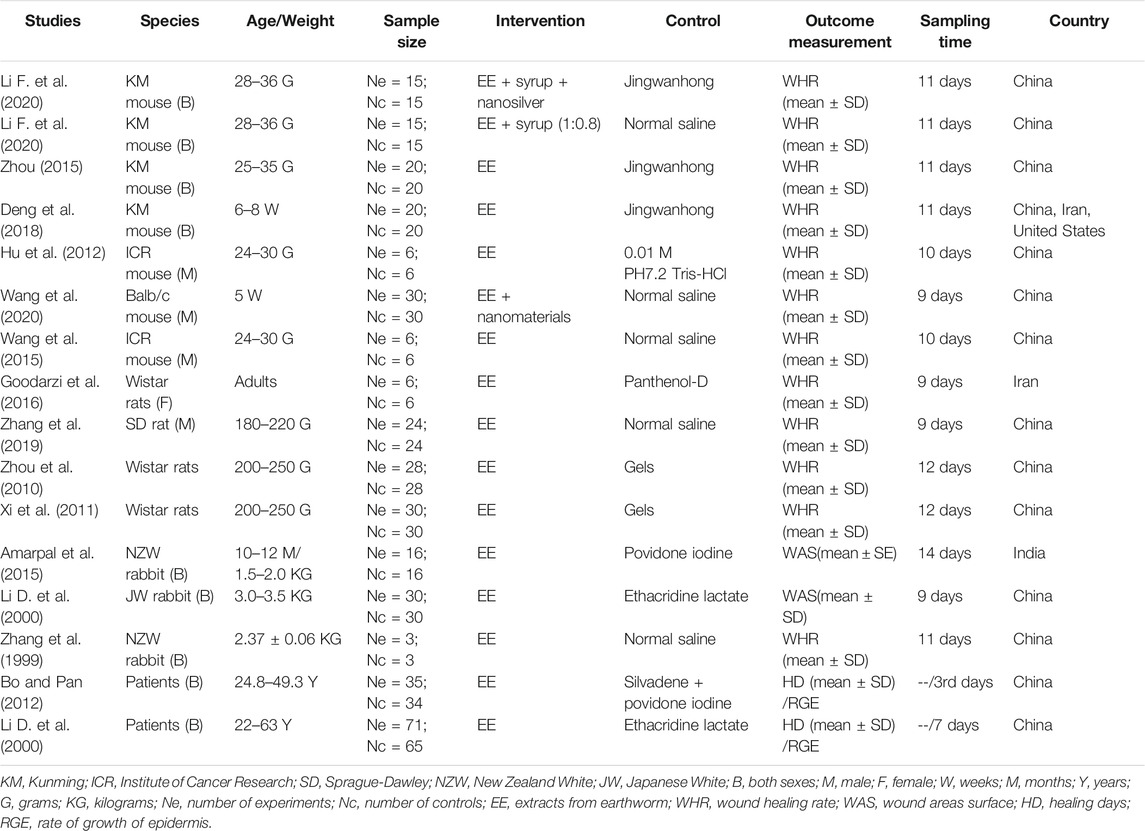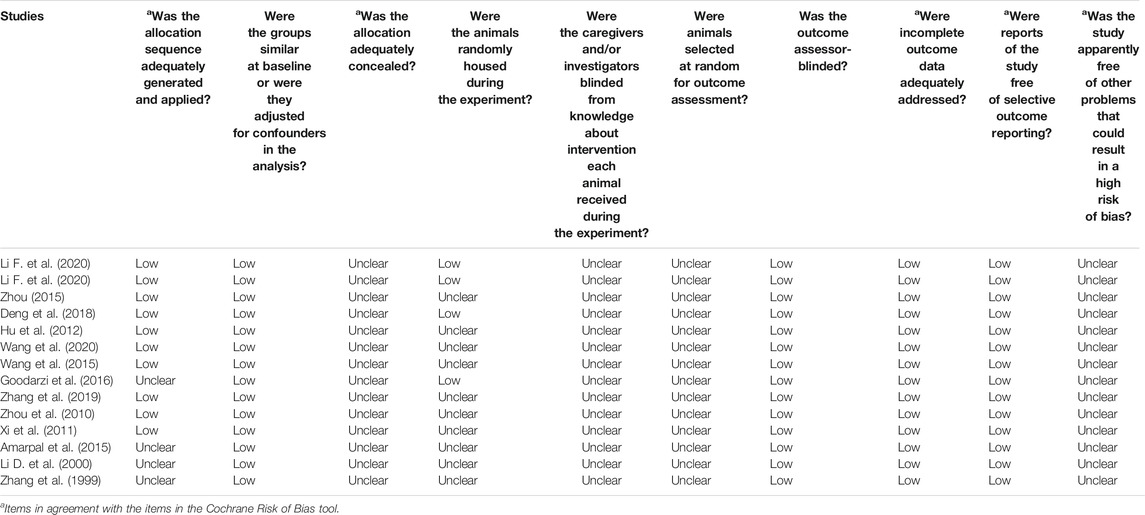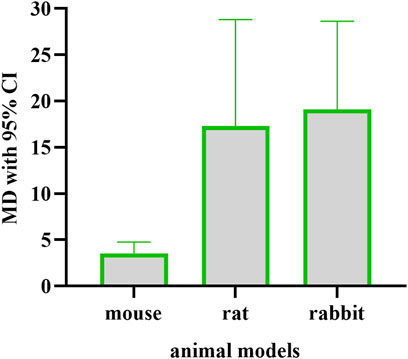- 1Medical Research and Experiment Center, Shaanxi University of Chinese Medicine, Xianyang, China
- 2Shaanxi University of Chinese Medicine, Xianyang, China
Background: Earthworm, also called dilong (Chinese language), has been used as a traditional Chinese medicine for thousands of years. Recently, some scientists believe that earthworm extracts (EE) can promote wound healing. However, its effectiveness remains controversial. We conducted a meta-analysis to evaluate the effect of EE on wound healing based on the healing rate.
Methods: We comprehensively reviewed literature that mentioned EE for wound healing in the PubMed, Cochrane Library, Embase, Web of Science, China National Knowledge Infrastructure (CNKI), VIP database for Chinese Technical Periodicals, and WanFang database that have been published until January 2021. We computed weighted mean difference (WMD) for analysis with RevMan 5.3 software in animal and human models groups. Two researchers independently selected studies and evaluated the risk of bias with the Cochrane Collaboration tool. The quality of the evidence was assessed with the Cochrane risk of bias tool. This study is registered on PROSPERO (CRD42020168400).
Results: From 2,486 articles, we selected 16 studies for analysis. EE treatment was associated with improvements in wound healing performance based on wound healing rate (mouse model: weighted mean difference (WMD) = 3.55, 95% confidence interval (CI): 2.34–4.77, p < 0.00001; rat model: WMD = 17.29, 95% CI: 5.75–28.82, p = 0.003; rabbit model: WMD = 19.29, 95% CI: 9.95–28.64, p < 0.0001). Clinical studies also confirmed that EE could reduce healing time in hospital (WMD = −8.94, 95% CI: −17.75 to −0.14, p = 0.05).
Conclusion: The results of this meta-analysis demonstrated the efficacy of EE on wound healing process. As a corollary, EE can be a useful natural product for wound healing drug development.
Systematic Review Registration: https://www.crd.york.ac.uk/PROSPERO/display_record.php?RecordID=168400, identifier CRD42020168400.
Introduction
The skin is the largest organ that protects the host from the external environment and maintains homeostasis (Richmond and Harris, 2014). Wounds provide entry points for exogenous materials and organisms into the body. Wound healing is a complex coordinated and intricate biological process that produces inflammation, proliferation, and remodeling phases (Campos et al., 2008). In clinics, physicians usually use antibiotics to treat injuries to prevent traumatic infections (Rowan et al., 2015). Although the wound healing process has been extensively studied, developing effective therapeutics for wound treatment remains difficult due to its complexity. Natural products are potential chemotherapeutic drugs for wounds (Kim et al., 2019). In China, earthworms (Lumbricus spp.), also called dilong, are used to treat various ailments, including burns, arthritis, itching, and inflammation. Earthworm extracts (EE) are important in the wound healing process (Matausic-Pisl et al., 2010; Bigham-Sadegh et al., 2016).
Establishing the acceleration effect of EE on wound closure by wound repair can be the first step toward drug design and future wound healing therapeutics. In this review, we analyzed the studies, including animal models and clinical trials, on the effect of EE on wound healing in comparison with conventional treatments, such as Jingwanhong (a traditional Chinese medicine) and normal saline. The data of wound healing rate were extracted and studied using the RevMan5.3 (Review Manager software, version 5.3, Copenhagen: The Nordic Cochrane Centre, The Cochrane Collaboration, 2014) and Stata 15.1 (Stata statistical software, version 15.1, Stata Corporation, College Station, Texas). This study aimed to determine the accelerated wound contraction potentials of EE on wound repair through a meta-analysis and systematic review. The outcome of this research is particularly important for the consideration of treatments for injury and for the development of new drugs from earthworm extracts.
Materials and Methods
The protocol was registered on the international prospective register of systematic reviews PROSPERO (CRD42020168400) and can be accessed at https://www.crd.york.ac.uk/PROSPERO/display_record.php?RecordID=168400. The PRISMA 2020 (Preferred Reporting Items for Systematic Reviews and Meta-Analyses) and AMSTAR 2 for assessing the methodological quality of systematic reviews were used as guidelines in identifying and selecting relevant studies (Page et al., 2021).
Search Strategy
The electronic databases (Embase, Web of Science, the Cochrane Library, PubMed, China National Knowledge Infrastructure (CNKI), VIP Database for Chinese Technical Periodicals (VIP), and WanFang) were searched by two independent researchers. All the databases were searched from their respective inceptions to January 2021. The following terms were used for search: “wound healing” OR “regeneration” OR “injury repair” OR “wound repair” OR “wound epithelialization” AND “Oligochaeta” OR “Dilong” OR “Earthworm” OR “Lumbricus terrestris” OR “Eisenia worm” OR “Eisenia foetida”. Study selection was restricted to the English and Chinese languages. Correspondence authors were contacted for unpublished studies when possible; however, no unpublished works were available because of two reasons: 1) No unpublished results satisfied the inclusion criteria. 2) The authors preferred not to disclose their work until it was submitted for publication. A detailed search strategy is presented in Supplementary Material S1.
Study Selection
The criteria for the selection of studies for our meta-analysis were as follows: 1) All studies should be designed with randomized controlled trials (RCT), and original data were available. 2) EE was used to cure wound healing. 3) Studies should have cognitive performance outcomes measured by wound contraction (animal models) or healing time (clinic trials). 4) Oral medication or normal saline was used for comparison. The exclusion criteria were 1) review or meta-analysis articles; 2) uncorrelated to the effect of EE on wound healing articles; 3) reporting duplicated data articles; 4) wound healing rate or healing days not reported in articles.
Data Extraction
Two investigators (Dong Wang and Zhen Ruan) independently reviewed and selected the studies based on the inclusion criteria. First author, publication year, species, number of experiments and controls, countries, and treatment methods for each group were identified and extracted from the method sections of each study. For animal model studies, wound contraction percentages (%) were extracted on the 10th day after injury. Alternatively, the nearest days were used instead, if the 10th day data were unpublished. For the clinical group, the healing time (days) and the rate of the growth of epidermis (%) were extracted for further analysis. Some simple arithmetic conversions were applied if the original data were not presented as wound healing rate or the format was not “mean ± standard deviation.”
Methodological Quality and Assessment of Studies
The risk of bias for all studies was assessed using the modified tool for “risk of bias” from the Cochrane Handbook for Systematic Reviews of Interventions, which was obtained from the RevMan5.3. Several aspects of included studies assessed by the two researchers (Dong Wang and Zhen Ruan) were random sequence generation; allocation concealment; blinding of participants and personnel; blinding of outcome assessment; incomplete outcome data; selective reporting; and other biases. A level of “high,” “low,” or “unclear” was given for each item. Any disagreement was discussed with a third investigator (Xuejing Wang). Because of some different aspects of animal studies and RCT, the SYRCLE’s risk of bias tool based on the Cochrane Collaboration risk of bias tool was also applied to animal studies (Hooijmans et al., 2014).
Data Analysis
RevMan 5.3 was used to analyze the data and generate forest and funnel plots. The pooled estimate was reported as weighted mean differences (WMDs) with 95% confidence intervals (CIs) for continuous outcomes. Either fixed-effect or random effect model was used to pool the effect sizes: if I2 < 50% and p ≥ 0.1, the pooled outcomes were calculated by the fixed-effects model; otherwise, a random-effects model was applied. Stata15.1 software was used to check publication bias. Publication bias was assessed using the funnel plots and Egger and Begg’s tests. We only checked publication bias in the mice and rat groups. The publication bias was not checked in other groups because of the number of enrolled studies; that is, rabbit and human groups only included three or less studies. Heterogeneity tests, including the Q and I2 statistics, were calculated; 25, 50, and 75% I2 scores were considered low, moderate, and high heterogeneities, respectively. Groups were categorized according to patients or animal models.
Results
Study Selection and Characteristics
Our search obtained 2,486 articles: 181, 18, 186, 1905, 100, 26, and 70 articles from PubMed, Cochrane database, Embase, Web of Science, CNKI, VIP database, and WanFang database, respectively. Finally, 14 articles (including 16 studies), with eleven and three articles in the Chinese and English languages, respectively, matched the inclusion criteria. The protocols of the literature search and study selection are summarized in Figure 1. Among the 2,486 articles, 517 repeated articles and 92 reviews/meta-analyses were removed. After screening the titles and abstracts, 1,842 articles unrelated to EE and wound healing were excluded. Finally, 35 articles were obtained for further research. A total of 21 articles were excluded (Supplementary Material S5), as follows: two articles uncorrelated to the effect of EE on wound healing; nine articles reported duplicate data; and 10 articles did not report wound healing rate (in animal model studies) or healing days (in clinical studies). The earliest included study was published in 1999, and twelve studies were presented after 2010. These articles were distributed among four countries, namely, India, Iran, United States, and China. The article of Deng et al. (2018) was written by authors from India, United States, and China. Among the 16 studies, seven, four, and three studies used mouse, rat, and rabbit models, respectively, and two studies were from clinical trials. The article of Li D. et al. (2000) provided two studies: one was from rabbit model experiments and the other was from clinical trials. Li F. et al. (2020) also provided two studies: one intervention group applied earthworm syrup and another one applied earthworm syrup nanosilver hydrogel patch. A total of seven mouse model studies contained Kunming mouse from the Institute of Cancer Research mouse and Balb/c mouse. Female Wistar and male Sprague-Dawley rats were used in the rat model studies. A total of 30 New Zealand and 16 Japanese white rabbits were used in the three rabbit model studies. In clinical studies, a total of 205 patients were enrolled in this meta-analysis with sample sizes ranging from 34 to 71. All participants were randomly assigned to the intervention group or control group. In this meta-analysis, the intervention methods of studies were EE, and the EE’s form and adjuvant were ignored. For example, in the study of Wang et al. (2020), EE was carried into nanomaterials, but we also consider that the intervention method is EE in analysis. Normal saline was commonly used as control (31.25%), and Jingwanhong (main compositions: Angelica sinensis, Angelica dahurica, Boswellia carterii Birdw., Arnebia guttata Bunge, and Commiphora myrrha Engl.) was used in three studies (18.75%). Gels, ethacridine lactate, and povidone iodine were used twice separately. Tris-HCl and panthenol-D were used once separately in mouse and rat models (Table 1).
Methodologies for the Bias of Selected Studies
The quality of enrolled studies is presented in Figure 2 and the quality of animal studies is shown in Table 2. Twelve studies clearly reported that random sequence generation was used in the research except in four studies. The risk bias of allocation concealment could not be assessed due to the lack of information from these studies. Two studies from clinical trials showed unclear risks in performances bias because the articles had insufficient information. Animals cannot understand the experiments even if the researcher explained the protocols to them in person, so the risk of performance bias is very low in animal models. The outcomes of animal studies were measured by the researchers, but we were unable to obtain enough information to assess the risk bias of blind outcome assessment. The data on the healing days of clinical trials were collected by the researchers and patients, and the risk was reduced. Incomplete outcome data were not reported, and all studies conducted selective reporting with a low risk of bias. No other types of bias were clearly indicated in general.
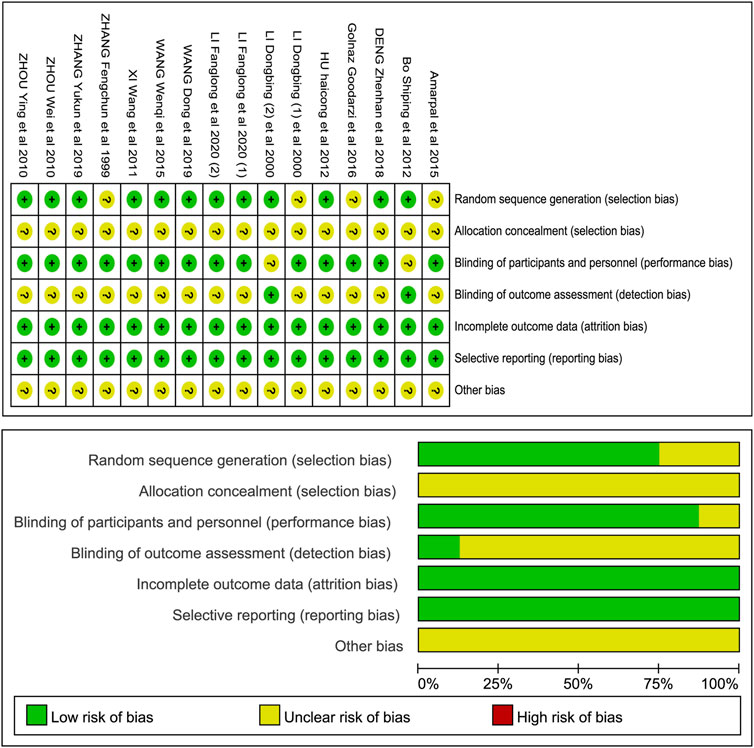
FIGURE 2. Risk of bias summary: review authors’ judgments about each risk of bias item for each included study.
Effects of EE in Animal Model
In summary, the selected 14 animal model studies were divided into three groups for meta-analysis. Half of the 125 animals were cured in the EE group, and others were treated in the control group. In the animal model studies, EE treatment was associated with increased wound healing rate (mouse model: WMD = 3.55, 95% CI: 2.34–4.77; rat model: WMD = 17.29, 95% CI: 5.75–28.82; rabbit model: WMD = 19.29, 95% CI: 9.95–28.64). The heterogeneity in the pooled results was I2 = 33% (p = 0.18), I2 = 99% (p < 0.00001), and I2 = 59% (p = 0.09) in the mouse, rat, and rabbit models, respectively (Figure 3). The test for overall effect (Z) was 5.73 (p < 0.00001), 2.94 (p = 0.003), and 4.05 (p < 0.0001) in the mouse, rat, and rabbit model groups, respectively.
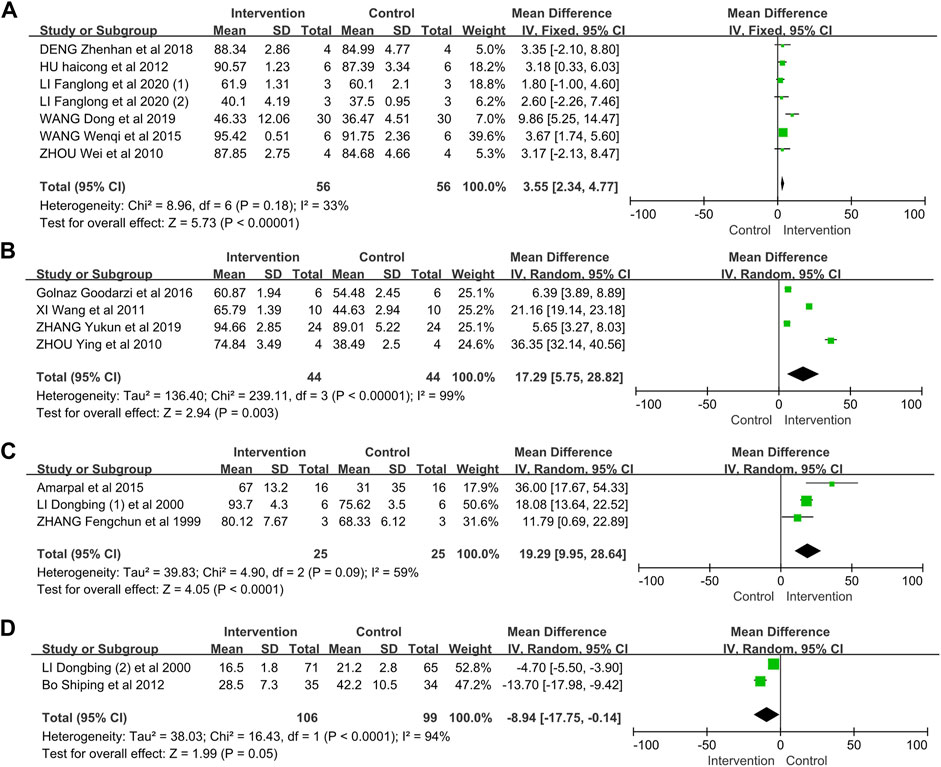
FIGURE 3. Meta-analysis on earthworm extract for wound healing. (A) Wound healing rate on mouse model; (B) wound healing rate on rat model; (C) wound healing rate on rabbit model; (D) healing time on clinic trials.
Effects of EE on Clinical Trials
In this meta-analysis group, we included 205 patients in two studies (Figure 3D). A total of 106 patients (male = 49; female = 57) and 99 patients (male = 49; female = 50) were cured in the EE and drug groups, respectively. The results of meta-analysis confirmed that EE could reduce healing time (WMD = −8.94, 95% CI: −17.75–−0.14), with significant heterogeneity in the pooled results (I2 = 94%, p < 0.0001). The test for overall effect (Z) was 1.99 (p = 0.05).
Publication Bias
Publication bias was only checked in the mouse and rat model groups because few articles were available in the other groups. We applied funnel plots, and Egger and Begg’s tests for outcomes to assess the potential publication bias of the included studies. With these studies, no evidence of extreme publication bias was observed (mouse model: Egger’s test: p = 0.593 and Begg’s test: p = 0.764; rat model: Egger’s test: p = 0.596 and Begg’s test: p = 0.734). The funnel plots are shown in Figure 4.
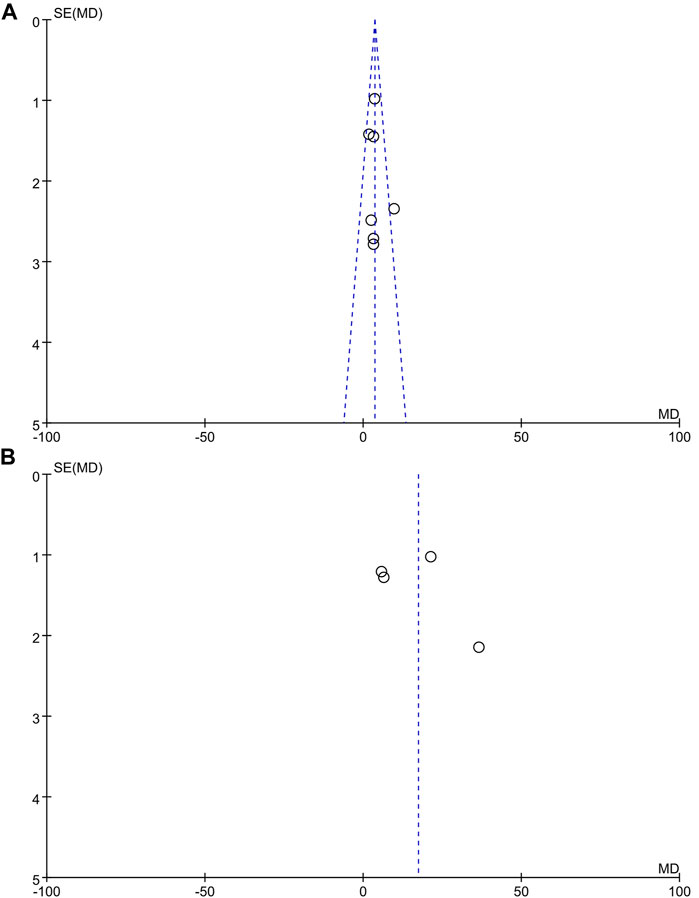
FIGURE 4. The funnel plot of earthworm extracts for wound healing rate. (A) Mouse model; (B) rat model.
Discussion
In this systematic review and meta-analysis, eleven and three Chinese and English language articles, respectively, were enrolled after critical selection. A total of 16 studies from articles were divided into animal and clinical groups. The animal groups contained mouse, rat, and rabbit models. The intervention methods used EE to cure the wound and compared the control methods with saline normal or conventional drug. The meta-analysis results indicated that EE performed better than drug or normal saline in terms of wound healing rate (Figure 3). The rat and rabbit model group showed high WMD, indicating that the effect of EE on rabbit and rat models was better than that on mouse model (Figure 5). In the mouse model, when the study of Wang Dong et al. (2019) (Wang et al., 2020) was eliminated, no significant heterogeneity existed (I2 = 0%, p = 0.94). This finding may be due to the presence of nanomaterial, which was used in the study as a drug release carrier. The main effective component is EE, but the nanomaterial can protect the extract, thereby improving stability and increasing potency. The extract was applied at days 1 and 7 after the injury, and the extract was used once daily, so the test for overall effect was increased to Z = 4.79 (p < 0.00001) when this study was removed. The heterogeneity in the rat model showed significance with the I2 = 99% (p < 0.00001). This result may be due to the fact that only four studies were included in this group. However, there was no directional change in the overall results after included studies were systematically omitted in turn, which indicated that these results are credible. In the rabbit model study, if the study of Amarpal et al. (2015) was excluded, then the heterogeneity was reduced to I2 = 6% (p = 0.30). Thus, this study was the main source of heterogeneity in the analysis. This result may be due to the fact that the sampling time (on the 14th day after injury) in this study was later than the sampling time (9th and 11th days) in other studies. The healing rate was slower with increasing number of days. So, the overall effect increased (Z = 8.19, p < 0.00001), and the WMD (95% CI) was reduced to 17.21 (13.09–21.33) when the study of Amarpal et al. (2015) was moved. The strains and weight of rabbits in these studies may also cause heterogeneity. The studies from clinical trials had high heterogeneity (I2 = 94%, p < 0.0001), because the types of injury differed. In the study of Bo Shiping et al. (Zhou, 2015), the injuries of patients included 35 burn and scald wounds (50.72%), 10 operation wounds (14.49%), 10 bedsore wounds (14.49%), and chronic ulcer wounds (20.29%). In the study of Li Dongbing et al. (Deng et al., 2018), the wounds are surgical injuries. The gap of the publishing years of the two studies was more than 10 years, during which the clinical environment and technology improved. Furthermore, the control drugs also differed. These discussed factors can increase the heterogeneity in this group. Although with high heterogeneity, the pooled results indicated that the EE could accelerate wound healing in clinic.
The articles of Li Dongbing et al. (Goodarzi et al., 2016) and Bo Shiping et al. (Bo and Pan, 2012) reported the rate of the growth of epidermis, and they also investigated the healing rate. The pooled results (Figure 6) present that the WMD (95% CI) was 2.69 (0.72, 4.67), the I2 was 83% (p = 0.01), and the effect size was Z = 2.67 (p = 0.008). These results indicated that EE can accelerate cell proliferation in the wound healing process.
In modern society, the number of patients with various injuries caused by traffic accidents and accidental events (scald, mechanical injury, etc.) is increasing rapidly. In addition to traumatic injury, millions of surgical wounds are created annually in the course of routine medical care in the United States and Europe (Eming et al., 2014). Wound healing is an important physiological process to maintain the integrity of skin after trauma. At present, the main method to treat the wound is to inhibit the growth of microorganisms with antibiotics, but it has some side effects such as mild skin rash and upset stomach (Cunha, 2001). Therefore, postwound repair has always been a hot research topic in the medical field. In recent years, it has been found that dilong as a traditional Chinese medicine has a unique effect on wound healing. In the Qing Dynasty, it was clearly pointed out that the dilong could “cure bruise and pock” in the book “Hui Yue Yi Jing.” The results of our meta-analysis also showed that EE can promote wound healing, which lays a foundation for future research and clinical application of EE in wound healing.
In this investigation, we also found that some researchers characterized other indexes that are not enrolled in the meta-analysis to indicate the effect of EE on wound healing (Table 3). The indexes are related to cytokines, amino acids, and cell proliferation rate. Mouse, rat, rabbit, and cells are used to test the effect of earthworm in these studies. Wei et al. (2009) also reported that EE may enhance sciatic nerve regeneration and function recovery after injury. Furthermore, Bigham-Sadegh et al. (2016) found that EE (G-90) can reduce inflammation and increase the maturity of fibrocytes and the aggregation of collagen fibers in tendons after tendon operation in rabbit. The results suggested the clinical potential of EE in the treatment of peripheral nerve injury in humans.
Several limitations to the present study should be considered. First, in this investigation, only several articles are enrolled for meta-analysis. We included fewer than 10 studies in each group, which may influence the results. Since fewer than or equal to three studies were included in the rabbit and human groups, we only assessed publication bias in the mouse and rat model groups. Second, due to the unclear chemical compositions of the EE and the lack of unified treatment regimens, this may be one of the reasons for the high heterogeneity of the results. Third, this study involves fewer countries; most of the studies are from China. It also shows that there are few studies on the treatment of wound with EE in the world. With additional studies published, a larger sample study will further confirm its efficacy in the future. With additional studies published in the future, and clear results can be provided.
Conclusion
Infection and inflammation are the common responses to injury, and antibiotics are usually used for treatment. However, the abuse of antibiotics decreases pharmacological efficacy and contraction of drugs. Our research shows a potential to discover new drugs from EE. Even with only 14 included articles, our meta-analysis further confirmed the effect of EE on wound healing process. In this review, we investigated 2,486 articles from seven databases and obtained 16 studies that met the inclusion criteria after critical selection. Then, the data from these studies were carefully analyzed, and we found that EE can reduce healing time and increase wound healing rate. The extracts can accelerate cell proliferation and multiplication after the injury according to biochemical and histomorphological experiments. Research also confirmed that the extracts have clinical potential for wound healing in clinic. Finding the main effect ingredients and creating a stable formation of EE should be the next step in this field.
Data Availability Statement
The original contributions presented in the study are included in the article/Supplementary Material; further inquiries can be directed to the corresponding author.
Author Contributions
Conceived and designed the experiments: DW, ZR, and ZT. Performed the experiments: DW, ZR, and XW. Analyzed the data: DW, ZR, RZ, and RW. Wrote the paper: DW and ZR.
Funding
We wish to acknowledge the National Natural Science Foundation of China (Grant No. 82104975), Scientific Project of Management of Traditional Chinese Medicine in Shaanxi Province (Grant No. 2019-ZZ-JC023), Shaanxi Province Key Research and Development Program (Grant No. 2021SF-361), and Scientific Research Foundation of Shaanxi University of Chinese Medicine (Grant No. 2020GP20) for supporting this work.
Conflict of Interest
The authors declare that the research was conducted in the absence of any commercial or financial relationships that could be construed as a potential conflict of interest.
Publisher’s Note
All claims expressed in this article are solely those of the authors and do not necessarily represent those of their affiliated organizations or those of the publisher, the editors, and the reviewers. Any product that may be evaluated in this article or claim that may be made by its manufacturer is not guaranteed or endorsed by the publisher.
Supplementary Material
The Supplementary Material for this article can be found online at: https://www.frontiersin.org/articles/10.3389/fphar.2021.691742/full#supplementary-material
Supplementary Material S1 | Search strategy.
Supplementary Material S2 | PRISMA 2020 Checklist.
Supplementary Material S3 | AMSTAR 2 Checklist.
Supplementary Material S4 | Original data.
Supplementary Material S5 | Not included articles.
References
Amarpal, A., Singh, R. V., Aithal, H. P., Kinjavdekar, P., Pawde, A. M., Singh, K. P., et al. (2015). Evaluation of the Healing Potential of Earthworm Coelomic Fluid in Full Thickness Skin Wounds in Rabbits. Veterinarski Arhiv 85 (2), 189–200.
Bigham-Sadegh, A., Arabi, M., Karimi, E., Karimi, I., and Oryan, A. (2016). Tendon Injury Healing with G-90 in a Rabbit Model: Biomechanical and Histopathological Evaluation. Veterinarski Arhiv 86 (3), 407–420.
Bo, S. P., and Pan, Y. J. (2012). Clinical Analysis of Earthworm Sugar Extract Combined with Local Oxygen Therapy to Promote Chronic Wound Healing in 35 Cases. China Pract. Med. 7 (20), 169–170. (in Chinese). doi:10.14163/j.cnki.11-5547/r.2012.20.143
Campos, A. C., Groth, A. K., and Branco, A. B. (2008). Assessment and Nutritional Aspects of Wound Healing. Curr. Opin. Clin. Nutr. Metab. Care 11 (3), 281–288. doi:10.1097/MCO.0b013e3282fbd35a
Chen, C. T., Lin, J. G., Lu, T. W., Tsai, F. J., Huang, C. Y., Yao, C. H., et al. (2010). Earthworm Extracts Facilitate Pc12 Cell Differentiation and Promote Axonal Sprouting in Peripheral Nerve Injury. Am. J. Chin. Med. 38 (3), 547–560. doi:10.1142/S0192415X10008044
Cunha, B. A. (2001). Antibiotic Side Effects. Med. Clin. North. Am. 85 (1), 149–185. doi:10.1016/s0025-7125(05)70309-6
Deng, Z. H., Yin, J. J., Luo, W., Kotian, R. N., Gao, S. S., Yi, Z. Q., et al. (2018). The Effect of Earthworm Extract on Promoting Skin Wound Healing. Biosci. Rep. 38 (2), 1–23. doi:10.1042/BSR20171366
Eming, S. A., Martin, P., and Tomic-Canic, M. (2014). Wound Repair and Regeneration: Mechanisms, Signaling, and Translation. Sci. Transl Med. 6 (265), 265sr6. doi:10.1126/scitranslmed.3009337
Goodarzi, G., Qujeq, D., Elmi, M. M., Feizi, F., and Fathai, S. (2016). The Effect of the Glycolipoprotein Extract (G-90) from Earthworm Eisenia Foetida on the Wound Healing Process in Alloxan-Induced Diabetic Rats. Cell Biochem Funct 34 (4), 242–249. doi:10.1002/cbf.3186
Grdiša, M., Popović, M., and Hrženjak, T. (2004). Stimulation of Growth Factor Synthesis in Skin Wounds Using Tissue Extract (G-90) from the Earthworm Eissenia Foetida. Cel Biochem Funct 22 (6), 373–378. doi:10.1002/cbf.1121
Hooijmans, C. R., Rovers, M. M., de Vries, R. B., Leenaars, M., Ritskes-Hoitinga, M., and Langendam, M. W. (2014). SYRCLE's Risk of Bias Tool for Animal Studies. BMC Med. Res. Methodol. 14, 43. doi:10.1186/1471-2288-14-43
Hou, Q. H. (2013). Study on Preparation of Earthworm Protein Gel and Treatment of Wound. M.S. thesis. Jinan, China: Shandong University. (in Chinese).
Hu, H. C., Li, C. F., Zhang, J. Y., Zhang, X. J., and Sun, Y. K. (2012). Experimental Study of the Broken Earthworm Extract on Mice Wound Healing. Huangshan, China: First National Prescription Composition Principle Summit Forum, 1–9. (in Chinese).
Hu, H., Zhang, C. H, Yu, Y., and Sun, Y. K. (2013). Analysis on the Differences of the Extract in the Earthworm Regeneration Period on NIH3T3 Cells. Chin. Arch. Traditional Chin. Med. 31 (5), 1126–1128. (in Chinese). doi:10.13193/j.archtcm.2013.05.168.huhc.065
Kim, H. S., Sun, X., Lee, J. H., Kim, H. W., Fu, X., and Leong, K. W. (2019). Advanced Drug Delivery Systems and Artificial Skin Grafts for Skin Wound Healing. Adv. Drug Deliv. Rev. 146, 209–239. doi:10.1016/j.addr.2018.12.014
Li, D. B., Wang, P., Zeng, Y. H., and Yaru, Z. (2000). Study on Lumbricus in Promoting Ligation Hemorrhoidectomy Postoperative Wound Healing. Chin. J. Integr. Med. 20 (12), 899–902. (in Chinese).
Li, F. L., Lu, X. Y., Feng, X., Chen, R., Wang, H. Y., and Li, X. (2020). Preparation and Pharmacodynamics Study of Hydrogel Patch Combining Earthworm Syrup with Nano-Silver. Chin. J. Mod. Appl. Pharm. 37 (15), 1842–1847. (in Chinese). doi:10.13748/j.cnki.issn1007-7693.2020.15.008
Matausic-Pisl, M., Cupic, H., Kasuba, V., Mikecin, A. M., and Grdisa, M. (2010). Tissue Extract from Eisenia Foetida as a Wound-Healing Agent. Eur. Rev. Med. Pharmacol. Sci. 14 (3), 177–184.
Page, M. J., McKenzie, J. E., Bossuyt, P. M., Boutron, I., Hoffmann, T. C., Mulrow, C. D., et al. (2021). The PRISMA 2020 Statement: An Updated Guideline for Reporting Systematic Reviews. BMJ 372, n71. doi:10.1136/bmj.n71
Richmond, J. M., and Harris, J. E. (2014). Immunology and Skin in Health and Disease. Cold Spring Harb Perspect. Med. 4 (12), a015339. doi:10.1101/cshperspect.a015339
Rowan, M. P., Cancio, L. C., Elster, E. A., Burmeister, D. M., Rose, L. F., Natesan, S., et al. (2015). Burn Wound Healing and Treatment: Review and Advancements. Crit. Care 19, 243. doi:10.1186/s13054-015-0961-2
Wang, D., Yang, H., Wang, R., Tang, Z., and Wang, X. (2020). Making Multilayer - Nanomaterials Dilong Protein Complex for Wound Healing in Mice. Chin. Arch. Traditional Chin. Med. 38 (05), 78–80. (in Chinese). doi:10.13193/j.issn.1673-7717.2020.05.018
Wang, W. Q., Hu, H. C., Zhang, Z. Q., Tang, H. Q., Zhang, S. F., and Sun, Y. (2015). Study on the Effect of the Extract of Broken Dilong on the Promotion of Wound Healing in Mice. World Sci. Technology-Modernization Traditional Chin. Med. 17 (7), 1449–1453. (in Chinese).
Wei, S., Yin, X., Kou, Y., and Jiang, B. (2009). Lumbricus Extract Promotes the Regeneration of Injured Peripheral Nerve in Rats. J. Ethnopharmacol 123 (1), 51–54. doi:10.1016/j.jep.2009.02.030
Xi, W., Yang, L., Wang, Y. S., Liang, H., Song, S. L., Wang, W. L., et al. (2011). Sodium Alginate/Chitosan Preparation of Earthworm Protein Gels and the Rats Ⅱ Degree burns to Promote Healing of Deep Research. J. Chin. Med. Mater. 34 (10), 1583–1588. (in Chinese). doi:10.13863/j.issn1001-4454.2011.10.038
Yang, Y., Hu, H., Wang, W., Duan, X., Luo, S., Wang, X., et al. (2017). The Identification of Functional Proteins from Amputated Lumbricus Eisenia fetida on the Wound Healing Process. Biomed. Pharmacother. 95, 1469–1478. doi:10.1016/j.biopha.2017.09.049
Zhang, F. C., Chen, Y. F., Su, Y. Z., and Hu, Q. F. (1999). Effect of Lumbricidae Eisemia Foetida Extract on Wound Healing. Chin. Pharm. J. 34 (2), 94–96. (in Chinese).
Zhang, M., Li, X., Liu, Y., Ye, F., and Qiu, G. (2006). Effects of Extract of Dilong (Pheretima) on the Scalded Skin in Rats. J. Tradit Chin. Med. 26 (1), 68–71.
Zhang, Y. K., Feng, Y. N., Bian, J. Q., Niu, W. Y., An, L. F., and Huang, J. (2019). Pharmacodynamic Study on the Healing of Rat Skin after Trauma with the Fresh Solution of Rhizoma Rehmanniae. World Latest Med. Inf. 19 (16), 13–14. (in Chinese). doi:10.19613/j.cnki.1671-3141.2019.16.007
Zhou, W. (2015). Study on Therapeutic Effect of Earthworm Extract on Scald in Mice. M.S. thesis. Changsha, China: Hunan Agricultural University. (in Chinese).
Keywords: earthworm extracts, wound healing, meta-analysis, systematic review, traditional Chinese medicine
Citation: Wang D, Ruan Z, Zhang R, Wang X, Wang R and Tang Z (2021) Effect of Earthworm on Wound Healing: A Systematic Review and Meta-Analysis. Front. Pharmacol. 12:691742. doi: 10.3389/fphar.2021.691742
Received: 08 April 2021; Accepted: 17 September 2021;
Published: 22 October 2021.
Edited by:
Francesca Borrelli, University of Naples Federico II, ItalyReviewed by:
Godwin Upoki Anywar, Makerere University, UgandaHongwu Wang, Tianjin University of Traditional Chinese Medicine, China
Copyright © 2021 Wang, Ruan, Zhang, Wang, Wang and Tang. This is an open-access article distributed under the terms of the Creative Commons Attribution License (CC BY). The use, distribution or reproduction in other forums is permitted, provided the original author(s) and the copyright owner(s) are credited and that the original publication in this journal is cited, in accordance with accepted academic practice. No use, distribution or reproduction is permitted which does not comply with these terms.
*Correspondence: Dong Wang, ZHdhbmcxOTg3QDEyNi5jb20=
†These authors have contributed equally to this work
 Dong Wang
Dong Wang Zhen Ruan2†
Zhen Ruan2†
